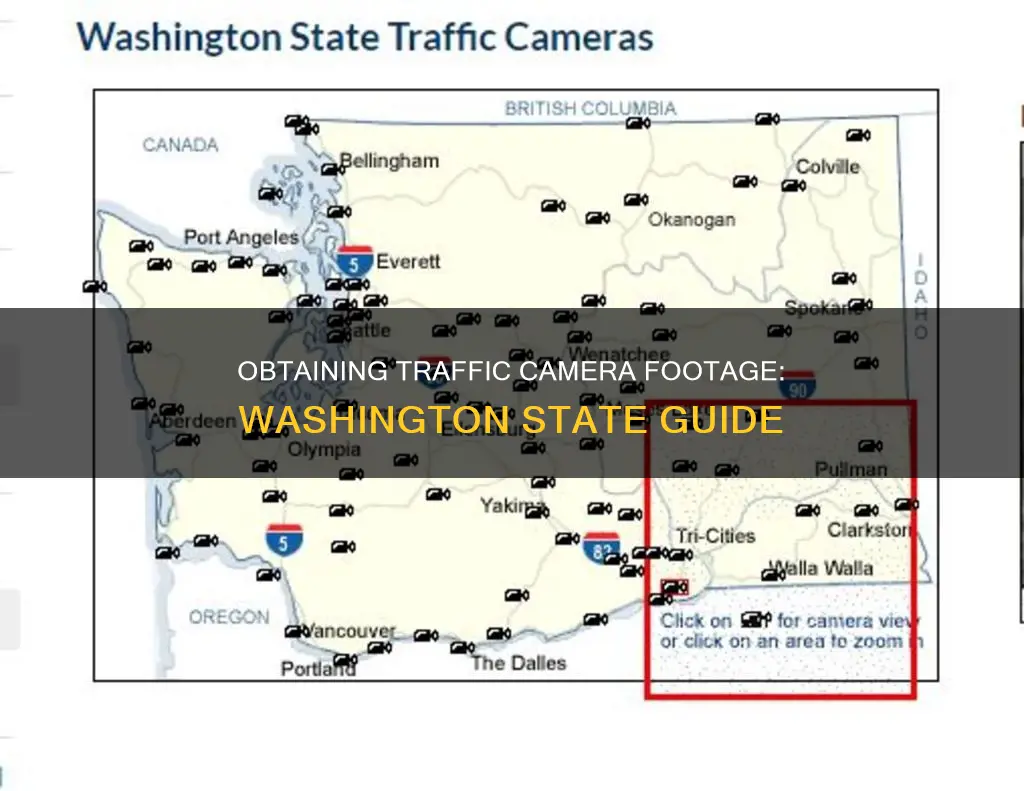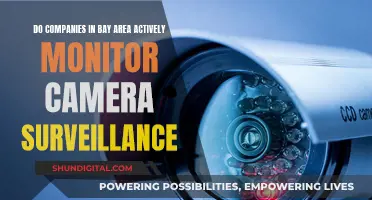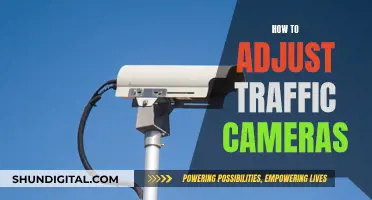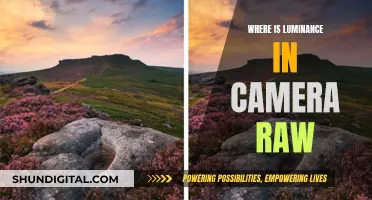
Traffic cameras are an increasingly common feature across Washington State, with new legislation allowing for their expanded use on city streets and county roads. These cameras are primarily used to detect red light and speed violations, with the aim of improving road safety and reducing traffic fatalities. While the presence of these cameras can be beneficial for accident investigations, obtaining footage from them is not always straightforward. In this article, we will outline the steps to request and access traffic camera footage in Washington State, including the different agencies that manage these records, and the retention policies that govern their availability.
What You'll Learn

How to request traffic camera footage in Washington State
If you are looking to request traffic camera footage in Washington State, there are a few things to keep in mind. The process may differ depending on whether the camera is owned by a government agency or a private individual or business.
Government-Owned Footage
If the traffic camera is owned by a city or county government, you will need to make a request as soon as possible as footage is often destroyed quickly to help administrators maintain records. According to Washington State retention requirements for law enforcement records, automatic traffic safety camera footage is typically retained until verification that no infraction has been captured.
To obtain footage, you can start by contacting the relevant city or county department that manages the traffic cameras. For example, in King County, you can contact the Roads department by email or phone. You can also visit the county's website to view real-time video images of traffic conditions in unincorporated areas.
Private Footage
If the traffic camera is owned by a private individual or business, the process may be as simple as making a written or verbal request for a copy of the video. This may include footage from surveillance security cameras or dashcams.
State Route Imagery
The Washington State Department of Transportation (WSDOT) collects digital images of the state highway system on a two-year cycle. While they do not retain video footage from their network of intersection and freeway cameras, you can request historical digital images by filling out the Digital Imagery Duplication Request Form.
Tips
- Act quickly to preserve video evidence before it is routinely destroyed.
- Consult a lawyer who can help you file an effective request to retain the video footage.
- Interview witnesses to determine if dashcam or bystander footage of a crash exists.
- Identify the location of any video surveillance cameras and municipal traffic cameras that may have captured the incident.
Cellular Trail Cameras: How Long Do Batteries Really Last?
You may want to see also

Traffic camera footage retention requirements
The retention of traffic camera footage in Washington State is governed by specific regulations, which are essential for maintaining public safety and addressing legal concerns. These retention requirements apply to different types of traffic-related recordings, including those from automatic license plate recognition systems, automatic traffic safety cameras, body cameras, dashcams, and custodial interrogation recordings. Here is an overview of the retention policies:
- Automatic License Plate Recognition Images: These images are retained until the exhaustion of the appeals process or until it is verified that no significant image has been captured. This ensures that relevant data is available if needed for legal or investigative purposes.
- Automatic Traffic Safety Camera Footage: This type of footage is typically retained until it is confirmed that no infraction has occurred. This allows for the identification of traffic violations, such as running red lights or speeding, and is an important tool for law enforcement.
- Body Camera Footage: Body-worn camera recordings by law enforcement officers are retained for a longer period. They are typically kept until 90 days after the recording date or until the related matter is resolved and the appeals process is complete. This extended retention period is crucial for maintaining transparency and accountability in police interactions with the public.
- Dashcam Footage: Similar to body camera footage, dashcam recordings from law enforcement vehicles are also retained for up to 90 days after the recording date or until the matter is resolved and the appeals process is concluded. This helps capture critical evidence related to traffic incidents or police activities.
- Custodial Interrogation Recordings: Recordings of custodial interrogations are retained until the final discharge of the offender from custody. This retention period is essential for legal proceedings, evidence preservation, and ensuring the protection of the accused's rights.
It is important to note that the retention requirements may vary based on specific circumstances or updates to Washington State laws and regulations. Additionally, different jurisdictions within the state may have their own specific guidelines regarding the retention and management of traffic camera footage. Therefore, it is advisable to refer to the most current laws and local ordinances when dealing with traffic camera footage retention.
Furthermore, when requesting traffic camera footage, it is crucial to act promptly. The footage is often not retained indefinitely and may be routinely destroyed after a certain period to facilitate record maintenance. As such, individuals seeking footage of a car accident or traffic incident should make their requests as soon as possible to increase the likelihood of obtaining the desired evidence. Consulting with a lawyer experienced in handling such cases can also be beneficial in navigating the process effectively.
Miami Camera Tickets: Your Options and Rights Explained
You may want to see also

The use of traffic cameras in King County
Traffic cameras are a valuable tool for managing traffic and enhancing road safety in King County, Washington State. These cameras are strategically placed to monitor real-time traffic conditions and provide critical information to traffic operators, media outlets, and travellers. The primary objective is to increase road safety, improve traffic flow, and inform motorists about adverse conditions, such as accidents or congestion.
The King County government operates a network of traffic cameras, primarily in unincorporated areas of the county. These cameras are web-based and connected to a remote server, allowing for the transmission of images to an image server and then to a web server for public access. Motorists can access the My Commute website or the King County traffic cameras webpage to view live traffic conditions before planning their routes. This pre-trip information assists travellers in making informed decisions about their mode of choice, estimated travel time, and preferred route.
The Traffic Control Center staff monitor the real-time traffic flow and can quickly respond to emerging issues. They have the ability to adjust signal timings, dispatch enforcement personnel, and provide updates to motorists. The cameras are not intended for speed enforcement or identifying speeders but rather as a tool to enhance traffic management and public safety.
In addition to King County's camera network, the Washington State Department of Transportation (WSDOT) also operates traffic cameras in the region. WSDOT collects digital images of the state highway system on a two-year cycle, providing a visual record for asset management, roadway data coding, and condition assessment. While WSDOT does not retain video footage from its intersection and freeway cameras, it does provide public access to some of its digital images through the State Route Web Tool (SRweb).
Traffic Cameras: The New Age Policemen?
You may want to see also

Washington State's new traffic camera law
ESHB 2384:
This legislation authorizes the use of automated traffic cameras to detect public transportation-related infractions and speed violations on state routes within city limits, specifically on city streets and in work zones. It allows civilian employees of law enforcement agencies or local public works/transportation departments to review and issue notices of infraction for camera-enforced violations. Additionally, it restricts the use of revenue generated by these cameras to specific traffic safety purposes.
SSB 6115:
The new law sets a penalty of $0 for a first-time safety camera violation and $248 for subsequent violations. It requires a final order to be entered, finding an individual liable for an infraction if they fail to respond to a notice. The Office of Administrative Hearings can offer payment plans for those unable to pay the fine. Courts and relevant government agencies can forward outstanding violations to the Department of Licensing, resulting in vehicle registration holds.
RCW 46.63.210-.260:
These regulations outline the permitted uses of automated traffic safety cameras by cities and counties. This includes detecting stoplight violations, railroad grade crossing violations, and speed violations in certain locations. Cities with populations over 500,000 have specific restrictions on camera usage, as outlined in RCW 46.63.260.
Placement of Cameras:
The new law includes detailed requirements for camera placement, aiming to minimize the impact of camera flash on drivers. Cameras can be placed in multi-arterial intersections, railroad grade crossings, and specific roadway zones such as public park speed zones, hospital speed zones, and roadway work zones. Cities can also place cameras on state highways classified as city streets, but they must notify the State Department of Transportation before installation. Cameras are not permitted at limited access facility on-ramps.
Signage and Recordings:
Jurisdictions must clearly mark camera locations at least 30 days before activation, using signs that meet Department of Transportation specifications. Cameras can only record images of violating vehicles and their license plates, ensuring the faces of drivers and passengers are not visible. Images can only be captured during the occurrence of violations.
Infractions and Notices:
Infraction notices can be issued by law enforcement officers, trained civilian employees of law enforcement agencies, or local public works/transportation department employees under the supervision of qualified traffic engineers. Non-law enforcement employees must undergo sufficient training and certification to review and issue notices. Infractions must be processed similarly to parking violations, following additional procedures outlined in RCW 46.63.220.
Compensation and Revenue Use:
Counties and cities must base compensation for camera vendors/manufacturers on the value of equipment and services, not on fine revenue. RCW 46.63.220 restricts how jurisdictions can utilize camera revenue. Jurisdictions with existing ordinances directing revenue use are exempt from these restrictions, allowing unrestricted use of funds from existing and some new cameras. Jurisdictions without a prior traffic camera program in place face limitations on revenue use, requiring funds to be directed towards traffic camera program costs, specified traffic safety activities, and the RCW 46.68.480 Cooper Jones active transportation safety account.
Reporting Requirements:
Before adding or relocating a camera, a jurisdiction must prepare an analysis of the proposed location, considering equity factors such as livability, accessibility, economics, education, and environmental health. Cities and counties using cameras must publish annual reports detailing crash data, infraction notices, and revenue usage.
Retention of Footage:
Footage from traffic safety cameras is for the exclusive use of authorized employees issuing infractions and cannot be released to the public or used in unrelated court proceedings. Retention requirements for law enforcement records specify that automatic traffic safety camera footage is retained until verification that no infraction has occurred.
Evading Traffic Cameras: Strategies to Avoid Unwanted Surveillance
You may want to see also

How to view traffic cameras in Washington State
Washington State has implemented several measures to enhance traffic safety and improve road conditions. One such measure is the installation of traffic cameras at various locations to monitor traffic flow, detect violations, and prevent accidents. Here is a guide on how to view these traffic cameras and access the footage they capture.
Understanding Traffic Cameras in Washington State
Traffic cameras in Washington State are typically managed by local governments and the Washington State Department of Transportation (WSDOT). These cameras are used for traffic management and enforcement purposes, including monitoring congestion, detecting violations such as running red lights or speeding, and improving overall road safety.
Locating Traffic Cameras
To view traffic cameras in Washington State, you can utilize several online resources:
- WSDOT Website: The WSDOT website provides a "live cameras" feature, allowing users to view real-time traffic conditions on state routes and highways. You can access this feature by visiting the WSDOT website and selecting the "live cameras" option.
- Local Government Websites: Many local governments in Washington State, such as King County, provide web-based traffic cameras on their websites. These cameras offer real-time traffic information and are designed to increase road safety and efficiency. You can visit the official websites of your local county or city to check if they provide similar traffic camera systems.
- Mobile Applications: WSDOT offers a traffic app that you can download on your mobile device. This app provides easy access to live camera feeds, travel alerts, and current travel times, helping you stay informed about traffic conditions on the go.
Accessing Traffic Camera Footage
Obtaining traffic camera footage in Washington State can be more complex, especially if the footage is owned by a municipal or state government. Here are some important considerations:
- Retention Policies: According to Washington State retention requirements for law enforcement records, automatic traffic safety camera footage is typically retained until verification that no infraction has been captured. Other types of footage, such as body camera footage and dashcam footage, have different retention periods.
- Prompt Action: It is crucial to act quickly when requesting traffic camera footage. In many cases, footage is routinely destroyed or recorded over to facilitate record maintenance. Therefore, submitting a timely request is essential to increase the chances of obtaining the desired footage.
- Legal Assistance: If you require footage of a car accident or a specific traffic incident, consider seeking legal assistance. An experienced lawyer can guide you through the process of filing an effective request to retain the relevant camera footage before it is routinely deleted.
- Contact Information: To request historical digital images or footage from WSDOT, you can fill out the Digital Imagery Duplication Request Form and contact their Digital Imagery group. Their email address is digitalimagingrequest@wsdot.wa.gov, and their phone number is 360-570-2481.
By following these guidelines, you can effectively view traffic cameras and access the footage they capture in Washington State. Remember to stay informed about the latest updates and resources provided by local governments and WSDOT to make the best use of these traffic monitoring systems.
Charging Camera Batteries: Power Bank Essentials
You may want to see also
Frequently asked questions
The Washington State Department of Transportation (WSDOT) provides live traffic camera footage via its website and mobile app. You can also request historical digital images of state highways by filling out the Digital Imagery Duplication Request Form.
If you are looking for footage of a car accident, you will need to act quickly as footage is often destroyed soon after it is recorded. You can request footage from municipal or state traffic cameras, or from private individuals or businesses, although obtaining footage from government bodies is a more complicated process.
King County, for example, does not regularly record its camera feeds, but you can contact them for help with road maintenance and traffic safety issues.







